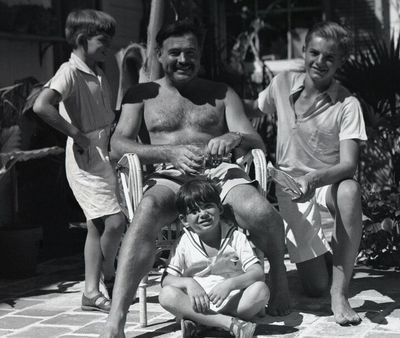‘Hemingway’: Ken Burns separates the man from myth in new documentary

The image many have of Ernest Hemingway is pretty simplistic: an iconic writer who favored stripped-down prose, and, in public, epitomized hyper-masculinity to an almost cartoonish degree.
The image filmmaker Ken Burns uncovered while working on his latest PBS documentary epic is, thankfully, much more complex.
“We were drawn to trying to get at a real Hemingway,” Burns said. “I think the persona of the wild man, the drunk, the bar guy, the big-game hunter, the big-sea fisherman is sort of what we inherit – the baggage we carry. But we lost everything the second we began this project. All of our baggage is somewhere else.”
In its place is “Hemingway,” a three-part, six-hour film that divides its time between dissecting the influential work of a literary giant and delivering a psychological examination of a man whose tumultuous life ended at the age of 61 when he put a shotgun to his head.
With actor Jeff Daniels voicing the title subject, Burns and co-director Lynn Novick level a critical eye at Hemingway, who had four wives and occasionally could be violently abusive toward them. He also hated his mother and became estranged from two of his sons. Some of his writing and letters revealed racist leanings.
So riddled with foibles was Hemingway that Novick went into the project with a discernible dislike for the author known for classic books like “The Old Man and the Sea,” “For Whom the Bell Tolls” and “The Sun Also Rises.”
“I wasn’t sure how I would feel spending six hours with him as a viewer,” she recalls. “He was really unkind and hurtful to people, and self-centered. … And he had a talent for becoming alienated from people who cared about him.”
But as she, Burns and writer Geoffrey C. Ward further pondered the burden of Hemingway’s “struggles and demons,” Novick developed more compassion for him.
“For me, it was like a full circle, actually, to appreciate his humanity,” she says.
The film rigorously explores the different sides of the man called “Papa” – and the contradictions.
For example, though Hemingway clearly relished his rugged man’s-man persona, he experimented with gender fluidity in both his writing and marriages. His wives were asked to cut their hair short to look like boys while he grew his long and took on the name of “Katherine” as they reversed roles in their sex life.
“What we need is a more nuanced sense of his sexuality – his very complicated and evolving sexuality,” Burns says. “… Maybe it was born when (Hemingway’s) mother twinned him, putting him in dresses and his sister in pants so they could be alike. Maybe it is born of some other thing. But he has a curiosity about role changes.”
And whether the dynamics of that role playing had anything to do with it or not, it is clear that Hemingway exhibited an acute ability to see things from a female perspective in his writing. Irish author Edna O’Brien, one of many literary experts interviewed in the film, points to Hemingway’s fabled World War I novel “A Farewell to Arms” as evidence.
Parts of that book, she says, “could have been written by a woman, (and) I regard that as a compliment.” She adds that Hemingway nailed all “the boy’s stuff, the man’s stuff, the horror of war. But when people put the book down, what will they remember? They’ll remember a woman dying in childbirth.”
Burns says he and his team weren’t interested in chasing headlines. After all, many of the film’s talking points have surfaced to varying degrees in the numerous biographies and critical studies devoted to Hemingway. But among its startling revelations are details about the multiple concussions and traumatic brain injuries the writer suffered and the cumulative effect they may have had on his mental state.
“This is a man whose life ends very tragically by his own hand,” Burns says. “And people have expounded on all sorts of different rays: the genetics, the madness that existed in his family, his own father’s suicide, the ideation that produced in him. … We are not going to be bold enough to say that this is the one thing that did it – that pulled the trigger, literally and figuratively – but that it is a whole complex set of things.”
While “Hemingway” apparently leaves no flaw unexposed as it delves deeply into the man’s personal life, it keeps coming back to the books and short stories, which, for the most part, continue to be held in high esteem by the authors, fans and experts who appear in the series.
“The writing only increased in its power and glory and majesty,” Burns says. “As I confronted all of this negative stuff, it became important that the art transcended it and basically didn’t excuse it.”
Hemingway is only the second author to be given the Ken Burns treatment, joining Mark Twain (2002). In addition to the voice work of Daniels, the film also features an impressive cast of women who give voice to Hemingway’s wives, including Meryl Streep (Martha Gellhorn), Keri Russell (Hadley Richardson), Mary-Louise Parker (Mary Welsh) and Patricia Clarkson (Pauline Pfeiffer). Narration is provided by Peter Coyote.
How to watch: “Hemingway” airs Monday-Wednesday at 8 p.m. on KSPS and 7 and 9 p.m. on KCDT.